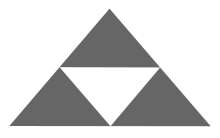Later Hōjō clan
The Later Hōjō clan (後北条氏, Go-Hōjō-shi) was one of the most powerful warrior clans in Japan in the Sengoku period and held domains primarily in the Kantō region.
| Later Hōjō clan 後北条氏 | |
|---|---|
 "The Three Dragonscales" - the emblem (mon) of the Hōjō clan | |
| Home province | |
| Parent house | Ise clan |
| Titles | Daimyō |
| Founder | Hōjō Sōun (posthumous) |
| Final ruler | Hōjō Ujinao |
| Founding year | 1493 |
| Dissolution | 1591 |
| Ruled until | 1590, Siege of Odawara |
History
The history of the family is written in the Hōjō Godaiki.[1]
The clan is traditionally reckoned to be started by Ise Shinkurō, who came from a branch of the prestigious Ise clan, a family in the direct employment of the Ashikaga shōguns. During the succession crisis in the 15th century, Shinkurō became associated with the Imagawa clan via the marriage of his sister to the Imagawa head, who led an army to Kyoto. Through this relationship Shinkurō quickly established a base of power in Kantō.
His son wanted his lineage to have a more illustrious name, and chose Hōjō, after the line of regents of the Kamakura shogunate, to which his wife also belonged. So he became Hōjō Ujitsuna, and his father, Ise Shinkurō, was posthumously renamed Hōjō Sōun.
The Late Hōjō, sometimes known as the Odawara Hōjō after their home castle of Odawara in Sagami Province, were not related to the earlier Hōjō clan. Their power rivaled that of the Tokugawa clan, but eventually Toyotomi Hideyoshi eradicated the power of the Hōjō in the Siege of Odawara (1590), banishing Hōjō Ujinao and his wife Toku Hime (a daughter of Tokugawa Ieyasu) to Mount Kōya, where Ujinao died in 1591.
The tea master Yamanoue Sōji, a disciple of Sen no Rikyū, was under the patronage of the Odawara lords. Following their fall, he was brutally executed on orders by Toyotomi Hideyoshi.
The clan ruled Sayama Domain in Kawachi Province through the Edo period.
Heads
The heads of the Late Hōjō clan were:
- Hōjō Sōun (1432–1519)
- Hōjō Ujitsuna (1487–1541), son of Sōun
- Hōjō Ujiyasu (1515–1571), son of Ujitsuna
- Hōjō Ujimasa (1538–1590), son of Ujiyasu
- Hōjō Ujinao (1562–1591), son of Ujimasa
Later Hōjō clan`s Prominent Castles
- Odawara Castle : Home Castle of Later Hōjō clan, Hōjō Ujiyasu
- Nirayama Castle ; Hōjō Sōun
- Tamanawa Castle : Hōjō Ujitoki, Hōjō Tsunashige
- Kozukue Castle : Kasahara clan
- Misaki Castle : Hōjō Ujinori
- Takiyama Castle : Hojo Ujiteru
- Hachigata Castle : Hōjō Ujikuni
- Hachiōji Castle : Hojo Ujiteru
- Ashigara Castle : Hōjō Ujimitsu
- Kurihashi Castle : Hojo Ujiteru
- Edo Castle
- Shimoda Castle ; Shimizu Yasuhide, Hōjō navy`s castle
- Nagahama Castle : Hōjō navy`s castle
- Tsukui Castle : Naitō clan
- Kawagoe Castle : Hōjō Tsunashige
- Yamanaka Castle : Matsuda clan
- Kasai Castle : Tōyama Kagetsuna
- Matsuida castle : Daidoji Masashige
- Fukasawa Castle
- Moto Sakura Castle : Chiba clan
- Karasawa Castle : Sano clan
- Koga Castle
In popular culture
Hyouge Mono (へうげもの Hepburn: Hyōge Mono, lit. "Jocular Fellow") is a Japanese manga written and illustrated by Yoshihiro Yamada. It was adapted into an anime series in 2011, and includes a fictional depiction of the Hōjō.
The Hōjō are a playable faction in the video game Shogun 2.
References
- Sansom, George (1961). A History of Japan, 1334–1615. Stanford University Press. pp. 253–255. ISBN 0804705259.
Further reading
- Turnbull, Stephen (2002). War in Japan: 1467–1615. Oxford: Osprey Publishing.